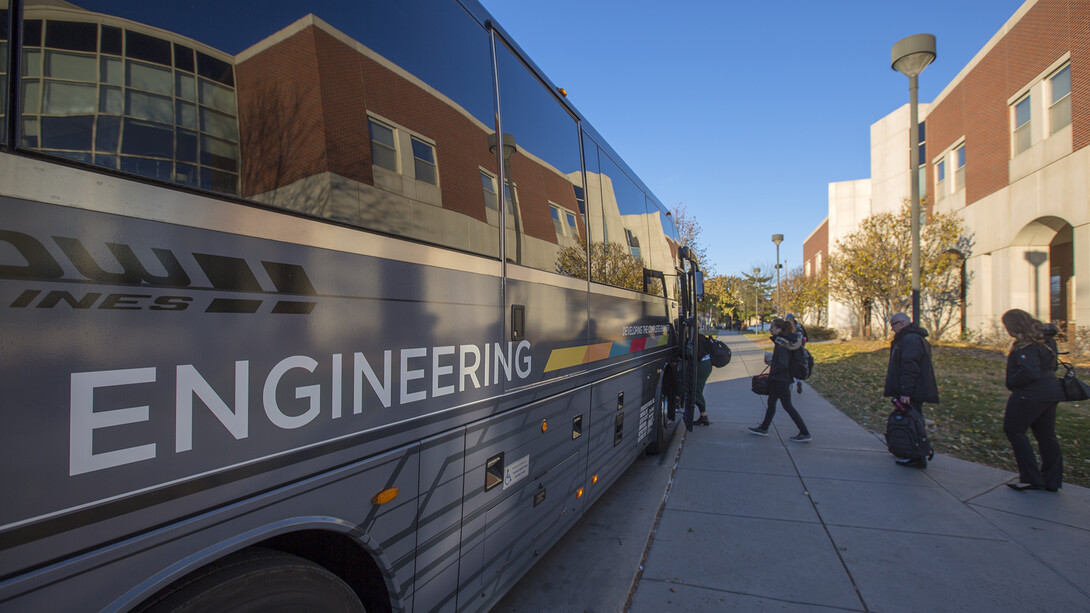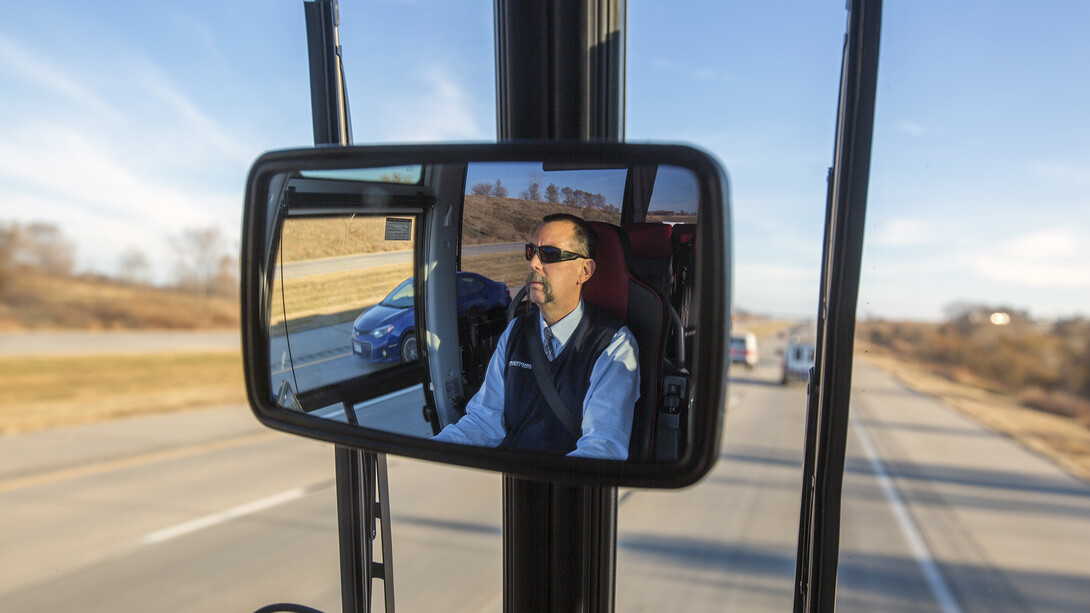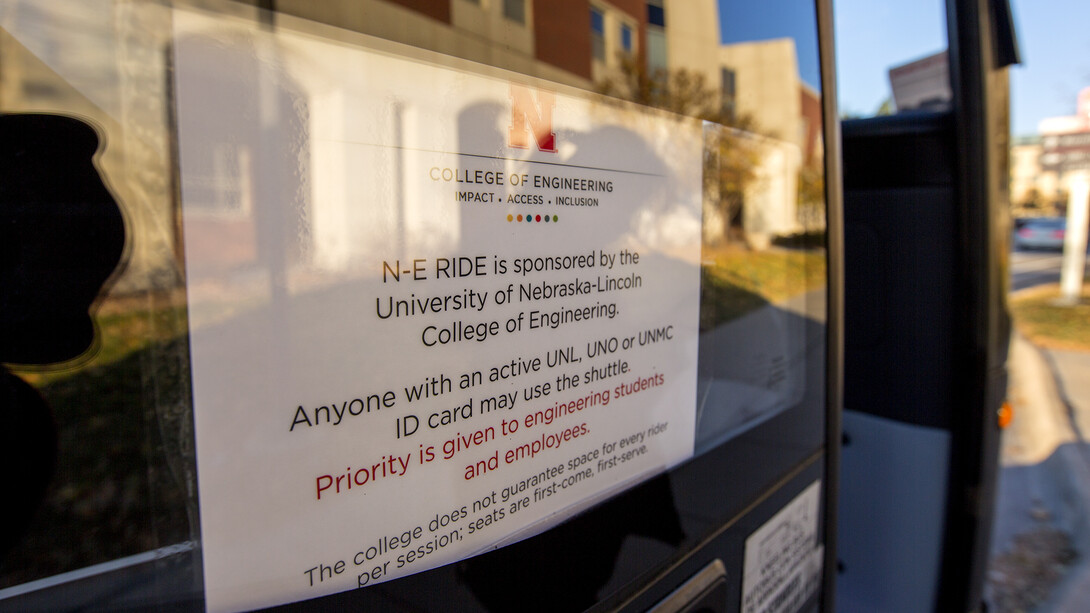
Editor’s Note — This is a story in an ongoing Nebraska Today series that spends an hour (sometimes more, sometimes less) at campus locations to highlight events or services. For more information, or to suggest a topic for the series, send email to tfedderson@unl.edu or call 402-472-8515.
It’s 8:03 a.m. on the south side of Othmer Hall and traffic crawls into campus as the N-E Ride shuttle rolls up to the curb.
As the door slides open, half a dozen riders shuffle up and reach into pockets and purses, pulling out NCards that allow them to ride for free. Now in its third year of operation, the shuttle service links Nebraska Engineering facilities on City Campus at the University of Nebraska–Lincoln and Scott Campus at the University of Nebraska at Omaha. It also makes regular stops at the University of Nebraska Medical Center.
“Two buses run so, if you can’t catch one, there’s always another to follow,” said Dustin Morton, a first-year driver with Arrow Stage Lines, which operates the shuttle service. “Routes start at 8 a.m. weekdays on each of the two campuses, with the last buses leaving at about 6 p.m. And, they run back and forth, shuttling students, faculty and staff throughout each day.”

It’s 8:17 a.m. and Morton pulls away from downtown Lincoln, accelerating the 40-passenger bus into the east bound lane of Interstate 80.
Riders settle into the leather seats, most opting to use the shuttle’s free Wi-Fi to wade through email, review work projects, complete classroom assignments or simply surf. Two of the six riders, both students, pull hoods over their eyes and settle in for a nap. Next stop is some 48 miles away at the Peter Kiewit Institute in Omaha.
The N-E Ride shuttle service grew from a proposal made by Lily Wang, associate dean for graduate programs and faculty development and professor of architectural engineering, to the engineering college leadership team. Wang’s idea was to offer the shuttle as a way to reduce the burden students face when they seek to take an engineering course offered away from their home campus.
Wang’s proposal also outlined how the shuttle could be useful to faculty and staff who travel between the two campuses for work purposes. And, if the shuttle could be linked to UNMC, it also would be a way to strengthen collaborations between the University of Nebraska campuses, including a biomedical research initiative.

It’s 8:45 a.m. and the N-E Ride shuttle glides past Eugene T. Mahoney State Park and across the Platte River. Natalija Ward and Tim Terrell sit toward the front of the bus, both working on their computers.
Ward, a sophomore civil engineering major, has used the shuttle in each of her two years at Nebraska. With a course load that has varied from 16 to 17 credits each semester, she finds the ride time to be valuable for finishing class assignments.
“For me, it’s definitely a nice thing for the university to offer,” Ward said. “I ride the bus twice a week on average. That’s four extra hours of study time that I would otherwise have to spend driving myself. And, in that four hours, I’m able to complete a whole paper for class.”
Terrell, senior grants manager for Nebraska Engineering, takes the bus every Thursday to work and meet with colleagues at the Peter Kiewit Institute. He’s been a regular rider since the service launched.
“It’s super convenient and a great way to get caught up on email and other work,” Terrell said. “The ride is amazingly quiet and smooth. And, if it works out timewise, I’d recommend it to everyone — students, faculty, and staff.”
Terrell’s shuttle rides also save university resources as, prior to the service being offered, he drove a university vehicle between engineering’s Lincoln and Omaha campuses.
Demand has helped the shuttle service grow from 11-passenger vehicle in fall 2014, to a 21-passenger shuttle in fall 2015 and now the 40-seat bus — similar to those used to transport travelers at major airports — fully branded with custom Nebraska Engineering graphics.
An average of more than 250 riders are using the service each week. Fridays are the most popular day, with the final buses trip filling up to near capacity.
The two buses make three roundtrips daily between Lincoln and Omaha. Along with the three NU campus stops, the shuttles also pick up students (by request) at an Interstate 80 transfer stop north of Exit 439.
The shuttle can also be tracked online and through an app available for download from iTunes or Google Play.

It’s a few seconds before 9:10 a.m. and Morton drives the bus down 72nd Street and to the front door of the Peter Kiewit Institute. Five of the passengers disembark, headed to class or work. Toward the rear of the bus, Marilynn Larson, an assistant professor of pathology and microbiology at UNMC, continues to work on her computer.
“When they opened up the bus service to research collaborators, I jumped at the chance to ride it,” said Larson, who lives in Lincoln. “The bus is wonderfully comfortable and offers a lot of nice features. Plus, it saves me time that I use to complete work and money since I’m not having to pump gas into a car every third roundtrip.”
She’s also found the ride useful for forging relationships with students.
“One in particular was great because she took the bus from Lincoln and was working on her doctorate at UNMC,” Larson said. “We spent much of our time together talking about her research project.”

It’s 9:21 a.m. and the shuttle pulls up to the Truhlsen Campus Events Center in the heart of the UNMC campus. Larson departs and Morton takes a break before starting the return trip to Lincoln.
For Morton, driving is a retirement gig after serving 32 years with Lincoln Fire and Rescue. He’s also father to a freshman honors student in the University of Nebraska–Lincoln’s College of Business.
“As a parent of student taking classes in Lincoln, I think this shuttle is a really great option for the university to offer,” Morton said. “It provides three really important functions. It saves money that doesn’t have to be spent on gas. It helps reduce the stress level for students, who can just sit back, relax and let us do the driving. And, it saves time, which is something everyone is too short on.”
It’s after 9:45 a.m. and Morton buckles back into the driver’s seat, shifts the bus into gear and steers it back toward UNO and almost a dozen waiting students.
“Time for the return trip to Lincoln,” Morton said.







